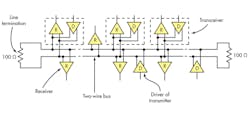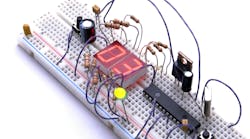What you'll learn:
- What is RS-232?
- Why was RS-232 important?
- Take our poll and see what others think of RS-232.
Control Design Podcast: The Legacy and Evolution of RS-232
In this episode of Control Intelligence, editor-in-chief of Control Design, Mike Bacidore, explains the history of RS-232 and its role in industrial manufacturing.
RS-232 (Recommended Standard 232) was introduced in 1960 for serial communication transmission of data. Though still in use today, it's been replaced by other communication and networking standards like USB and Ethernet for most applications. RS-232 connectors were ubiquitous on IBM PC-compatible systems and many commercial and industrial systems in the past. It's just one of many serial standards.
Here are some interesting facts, articles, and podcasts about RS-232. Take our RS-232 poll if you get a chance.
The standard connector was a DB-25 that supported all signals for the interface. However, the DE-9 was more common in the long run as all of the signals were rarely needed (Fig. 1). Dan R. dropped me a note about correcting the DB-9 reference to DE-9.
RS-232 Pins
The voltage level was initially ±24 V p-p and dropped to ±12 V p-p with EIA RS-232-C. The serial protocol could vary and usually included a start bit, data bits (typically 7 or 8), an optional parity bit, and one or more stop bits. The baud rate and serial encoding had to be set at both ends to operate properly. This was fixed for most applications.
One application for RS-232 connections involved handling acoustic modems. Many of these implemented baud rate recognition by expecting an initial handshake character and tracking the bit duration. Other techniques were used as well. A typical connection was 9,600 baud with eight data bits, no parity, and one stop bit.
More RS-232 Articles
RS-232 remains an important tool which is why we have a lot of serial communication articles on Electronic Design including these.
Serial Communications 101
This eBook is a collection of Electronic Design articles covering different aspects of serial interfaces and protocols including RS-232.
Other RS-232 Resources
More TechXchanges on Electronic Design
About the Author
William G. Wong
Senior Content Director - Electronic Design and Microwaves & RF
I am Editor of Electronic Design focusing on embedded, software, and systems. As Senior Content Director, I also manage Microwaves & RF and I work with a great team of editors to provide engineers, programmers, developers and technical managers with interesting and useful articles and videos on a regular basis. Check out our free newsletters to see the latest content.
You can send press releases for new products for possible coverage on the website. I am also interested in receiving contributed articles for publishing on our website. Use our template and send to me along with a signed release form.
Check out my blog, AltEmbedded on Electronic Design, as well as his latest articles on this site that are listed below.
You can visit my social media via these links:
- AltEmbedded on Electronic Design
- Bill Wong on Facebook
- @AltEmbedded on Twitter
- Bill Wong on LinkedIn
I earned a Bachelor of Electrical Engineering at the Georgia Institute of Technology and a Masters in Computer Science from Rutgers University. I still do a bit of programming using everything from C and C++ to Rust and Ada/SPARK. I do a bit of PHP programming for Drupal websites. I have posted a few Drupal modules.
I still get a hand on software and electronic hardware. Some of this can be found on our Kit Close-Up video series. You can also see me on many of our TechXchange Talk videos. I am interested in a range of projects from robotics to artificial intelligence.









